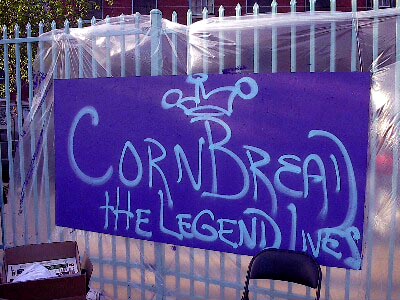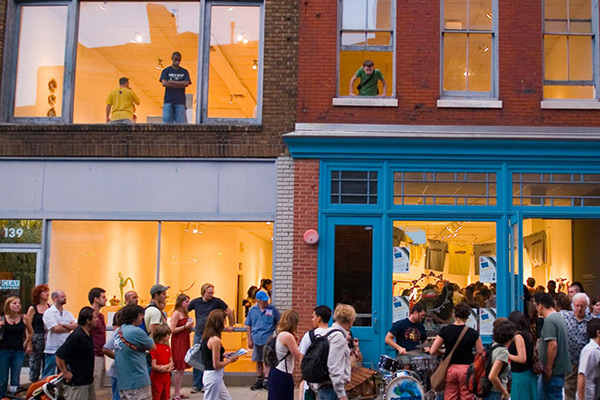Serendip is an independent site partnering with faculty at multiple colleges and universities around the world. Happy exploring!
AnotherAbby's blog

Thomas Roe's POV
The communal spaces and open water could only do so much to cleanse the place of its past.
Surely at this point any visitor entering the penitentiary, as one would enter a museum, would not be met with _???_* but a faint vibe, reminiscent of the true horrific conditions of this institution.
No matter, Eastern State as it is now, a true institution of learning, is the best form of itself that has ever been and undoubtedly could ever be.
I see the ultimate failure of what could have been and excellent way to reform prisoners.
I see how everyone lived and cannot imagine how they managed to stay alive—the conditions this place holds serves to no ones sustainability to survive.
Communication can’t be stopped.
Eastern State Penitentiary now looks the way it made the prisoners feel: empty, broken, and alone.
People here visiting with curiosity, with awe for the idea of penitentiary, don’t know how the inmates’ lives here were.
It is still in no better condition that it was when he was alive, but now that the context has changed, it is looked on with more reverence than it deserves.
It is very much the same; it is harsh and unforgiving.
Even the building itself is decaying, like all these past objects have the structure of enclosure and abuse and falling.

Moving Away--A Rethought Essay: or, If I hear the word "socioeconomic" one more time I'm going to snap
Imagine moving house.
Packing up, leaving, and not looking back.
Now, imagine that you new house is for all intents and purposes the same as your old one, because your socioeconomic status is based on where you live and your mobility is limited, so you have to live in basically the same place.
That situation is a very loose interpretation of the way Marxist economic theory works in regards to a person’s housing situation.
In NW, Zadie Smith’s novel about people living in the Northwest portion of London, the three main characters—Leah, Natalie, and Felix—are all defined by their peers and themselves by their housing situations.

Marxism and You: For Realtors
My last paper was very all over the board. I definitely don’t think I zoomed in enough with what I was saying, and my ideas were pretty scattered as well. This week, I’d like to totally change my lens and rewrite the paper entirely, using the Marxist lens, and focus on the living spaces of the characters and how that represents their socioeconomic status and defines them throughout the book. There’s a lot to work with there, from Felix and his father’s experiences in the community houses, to Natalie/Keisha’s big move, and even Michele telling Leah he doesn’t want their children to grow up in the flat they live in, with the sign out front, because it will define their lives. Plus, in general, the book does focus a lot on the neighborhood (as if the title wasn’t a tip off), so by comparing the living arrangements and way society judges the people living their per Marxist theory, I think I might have a much better paper.

Something I stumbled across....

Zen Pencils 75: L.P. Jacks, Work and Play
http://zenpencils.com/comic/75-l-p-jacks-work-and-play/
A lot of the work Gavin Aung Thang does relates back to our class, but I thought this one was particularly relevent to our discussions. Also, Zen Pencils is just a fantastic comic.

The End of the World as Felix Knows It
ex·is·ten·tial·ism (n)–
A philosophy that emphasizes the uniqueness and isolation of the individual experience in a hostile or indifferent universe, regards human existence as unexplainable, and stresses freedom of choice and responsibility for the consequences of one's acts.
Throughout the course of Zadie Smith’s novel NW, the reader is treated to three different yet concurrent perspectives from residents of the NW neighborhood in London. The novel stars Leah Hanwell, the perennial underachiever, Felix Cooper, who is actively turning his life around, and Natalie Blake, née Keisha Blake, who on the surface seems the happiest and most successful of the three, but has her own demons to deal with. Each character has chapters following his or her life, leading up to the annual neighborhood Carnival. Besides the neighborhood itself, one of the points of the novel that ties all three sections together is Felix’s death the night before Carnival. It is referenced in Leah’s chapters, experienced in his, and the aftermath is mentioned in Natalie’s. Smith uses the intersection of these perspectives within the city in regards to Felix’s death as a tool to express the ideas of existentialist philosophy, structuring the story to show the connections in order to expose the meaninglessness in the lives behind those connections.

NW by AA
I guess, like many others, I am curious about how Smith treated all the different characters who came from the same background, particularly with Natalie/Keisha. Her story really intrigued me the most; from the moment I met her in Leah’s section. What was most poignant to me was how Leah described the way Natalie would have had to really ignore or repress her origins in the neighborhood in order to truly be happy in the life she carved out for herself, which got me thinking about the ideas we’ve talked about with authenticity. I’m left wondering what Nat’s apparent inauthenticity is what left her feeling trapped, like she was always living her life for someone else rather than for herself, and how she’s seen accordingly. That idea also contrasts a lot with Leah, who’s living, for the most part, with only herself in mind, as shown when she gets an abortion despite Michele’s desire for a child. Nat is the “successful” one, and Leah is the one who never lived up to whatever potential she had, but both are rather unsatisfied with their lives.
This also comes back to the novel as a tool with which Smith explores existentialism with relatable characters in everyday situations, which lead me to think about the ultimate futility of the lives of these characters and, really, my own life.

Midterm Evaluation-The Musical
(Disclaimer: This paper is not a musical.)
-So do you go into Philly all the time?
-Yeah, I’ve gone in most weekends. But it’s for a class. Try to gloss over the description of what an E-Sem is. You’ll lose her attention.
-So where have you been?
Drop names. Things people will know and be able to connect with regardless of whether or not they’ve been to Philly within the last twenty years.
-Oh you know, some museums, some places around South Street, the Italian Market, and a bunch of other places. We wander, mostly.
-Have you been to the art museum? You have to go to the art museum.
-Yeah, I haven’t been in yet this trip, but definitely, yeah. Thank her nicely for the tip. Refrain from telling her it’s one of the most iconic places in Philly and of course you’re going to go soon.
-Good. Eat a cheesesteak for me when you get back!
-Yeah, I will! Thank her again and secretly think that she wouldn’t know where to get a good cheesesteak if she ever made it to Philly.

Failure and the Art of Success
I was just reflecting a little on this evening's events and wanted to make a post about it.
At Zadie Smith’s talk tonight, I really wanted to ask her about her views on failure as a part of the creative process. I’ve always thought that the ability to fail but continue on despite that is one of the most important parts of a creative process and creating art. I mean, it stands to reason, because if you’re great at something from the very beginning, what’s the point of continuing to work at it? And, conversely, if you fail and give up, of course you’re not going to make something that matters to the creative world, because you’ve given up.
Basically, for me, the constant reality of my own failings and shortcomings are what keep me constantly striving to improve at something. I write a lot, hate almost all of it, and don’t show it to anyone. I have a lot of comedy sketches and sci-fi stories saved on my computer that are never going to see the light of day again, and plenty of art pieces that are only still around because my mom wants to meticulously archive my childhood and teen years.

Tag-A-Long
 |
 |
Philadelphia, 1967: Darryl McCray begins painting his nickname, “Cornbread”, on the streets of North Philadelphia to get a girl’s attention.
Philadelphia, 1984: The Philadelphia Anti-Graffiti Network (PAGN) is established to combat vandalism.
Philadelphia, 2013: The battle over graffiti rages on.
Philadelphia’s First Friday is an art festival of sorts that Old City organizes on the first Friday of every month. Rain or shine, fine art galleries between Front and Third, and Market and Vine streets can be found with open doors welcoming world-weary Philadelphians into their wine-scented interiors.

Breadcrumb Trail: Director's Cut with Commentary

Stop 1: Philadelphia Inquirer article about two new NBC and ABC shows that take place in the city (Super Fun Night and the Ironside remake).
Stop 2: Which TV shows have been set in Philly?
http://en.wikipedia.org/wiki/Category:Television_shows_set_in_Philadelphia,_Pennsylvania
Ahh, Wikipedia. Always ready with a list I didn't know existed.
Stop 3: http://en.wikipedia.org/wiki/It%27s_Always_Sunny_in_Philadelphia
Well, I probably didn't need the Wikipedia list to get this one.....
Stop 4: Hey! Rob McElhenney and Sweet Dee really opened a bar in Philly to be like Paddy's Pub! Let's google it!
http://macstavern.com/
Stop 5: I'm going to look at their reviews on Yelp. It's probably just a gimmick-y place where die-hard fans go to spend too much money....
http://www.yelp.com/biz/macs-tavern-philadelphia


